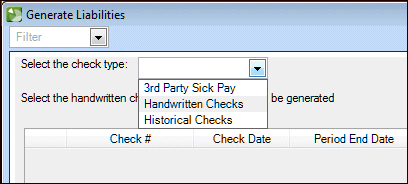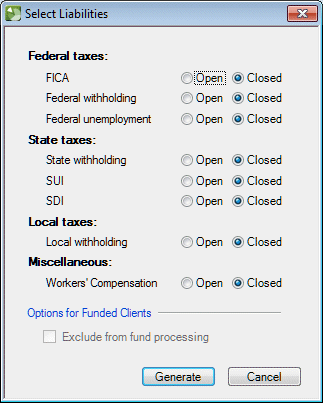We moved!
Help articles have been migrated to the new Help and Support. You can find help for your products and accounts, discover FAQs, explore training, and contact us!
Using the Enter Transactions or Enter Batch Handwritten Payroll Checks screen, you have the ability to enter earnings history for employees and to choose which liabilities to generate from that data and whether they should be generated as open (unpaid) or closed (paid).
Historical payroll data is entered by creating handwritten checks for the employee. You can either enter each historical check separately (to generate daily liabilities) or combine them into month-to-date, quarter-to-date, or year-to-date wage amounts.
To begin entering historical payroll data, follow the procedures below.
Entering employees' historical earnings
- Add employees' earnings in either the Actions > Enter Transactions screen or the Actions > Enter Batch Handwritten Payroll Checks screen. If you enter the checks in the Enter Transactions screen, be sure to specify the check number for each check, thus creating it as a handwritten check. For more information, see Entering individual payroll checks and Entering batch handwritten payroll checks.
- If you enter the checks in the Enter Transactions screen, you can click the Generate Liabilities for Handwritten Payroll checks link at the bottom of the screen to create open or closed liabilities.

Notes:
- You cannot print check stubs for handwritten payroll checks.
- If you have the Prompt to generate liabilities for handwritten payroll checks in Enter Transactions option turned on in the Firm > Preferences screen, when you leave the Enter Transactions screen Accounting CS will prompt you to generate the liabilities for the handwritten payroll checks you just entered.
Generating liabilities for handwritten payroll checks
- In the Generate Liabilities dialog, use the Filter field to filter the list of handwritten payroll checks that are available to generate liabilities.
- From the Select the check type drop-down list, choose the type of check that the handwritten checks truly represent. The options are 3rd Party Sick Pay, Handwritten Checks, or Historical Checks.

- 3rd Party Sick Pay. When this option is chosen, the liabilities generated for the checks in the Checks grid will be open for all employer taxes (FICA-SS, FICA-Med, FUTA, and, in some cases, SUI and Local). No liabilities will be generated for employee taxes (including the employee portion of FICA-SS and FICA-Med).
Note: If the employee status on a payroll check is Independent Contractor, the check will not be associated with any employer taxes and will therefore not generate any liabilities.
- Handwritten Checks. When this option is chosen, historical payroll checks remain posted to the general ledger, and all liabilities, both the employee and employer portions, will be generated as open. This includes liabilities associated with tax agents and payroll agents.
- Historical Checks. When this option is chosen, all tax agent liabilities associated with the employee, both employee and employer portions, will be generated. When you click the Generate button, the Select Liabilities dialog displays to enable you to choose which liability types to generate as open or closed.
- Closed liabilities. These flow to the payroll tax forms as payments, but they will not post to any GL accounts, nor will they appear in a bank reconciliation.
- Open liabilities. These become available to process tax payments for in the Payroll Liabilities tab of the Print Checks screen or the Manage Impound Payments screen. When those tax payments are actually processed, these payments will post to the appropriate GL accounts and will appear in a bank reconciliation. Note that you can also choose to exclude from fund processing any open liabilities that you generate.
Notes
- Historical checks do not post to any GL accounts and will not appear in a bank reconciliation. When a manual/handwritten check is changed to a historical check, the application removes the transaction from the general ledger.
- To revert a historical check back to a manual check, the historical check must be deleted and a new manual check entered to replace it.
- 3rd Party Sick Pay. When this option is chosen, the liabilities generated for the checks in the Checks grid will be open for all employer taxes (FICA-SS, FICA-Med, FUTA, and, in some cases, SUI and Local). No liabilities will be generated for employee taxes (including the employee portion of FICA-SS and FICA-Med).
- The Checks grid displays the list of all handwritten payroll checks for the current client that meet the criteria you specified in the Filter field and for which liabilities have not already been generated. Mark the checkboxes next to the checks for which you want to generate liabilities.
Notes
- If the Do not create tax liabilities checkbox is marked on the Payroll taxes tab on the Setup > Clients screen, no checks will be available for which to generate liabilities.
- Payroll checks that are marked as cleared in the Actions > Reconcile Bank Accounts screen are not listed in the Checks grid.
- When you have selected all the appropriate checks, click the Generate button.
For third-party sick pay and handwritten checks: The liabilities will be created as specified in step 5 and the Generate Liabilities dialog closes.
For historical checks: The Select Liabilities dialog displays, where you can choose whether specific types of liabilities should be generated as open or closed.
- If you are recording historical checks, for each tax type choose whether to generate the liabilities as open or closed. All tax types display in this dialog whether or not the client has employees subject to that tax type (local withholding, for example).

Note: Choosing Closed will generate both the liability and a payment for the full amount of the liability, so it is recorded as paid. Choosing Open will generate only the liability, recording it as unpaid.
- Click the Generate button to generate the liabilities as you have specified and return to the Enter Transactions screen.
Note: After the liabilities have been generated for a payroll check, it can no longer be modified, but you can delete the check and then re-enter it.
See also: Adding historical or closed liabilities
Was this article helpful?
Thank you for the feedback!



